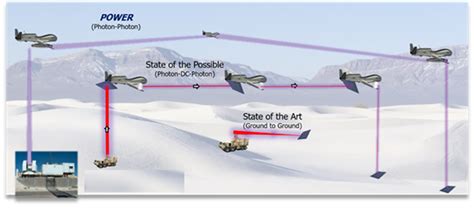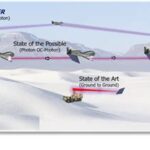
DARPA has achieved a significant breakthrough in wireless power transmission, successfully beaming energy over a distance of five miles – enough to pop popcorn. The demonstration marks a major milestone in the agency’s efforts to develop a reliable and scalable wireless power network for military applications and potentially civilian use.
The U.S. Defense Advanced Research Projects Agency (DARPA) has achieved a major milestone in wireless power transmission, successfully beaming sufficient energy across five miles to pop popcorn. This demonstration, part of the Persistent Optical Wireless Energy Relay (POWER) program, signifies a major step forward in developing a robust and scalable wireless power grid capable of supporting military operations and, potentially, revolutionizing energy distribution for civilian applications. The experiment not only proved the feasibility of long-range wireless power transfer but also highlighted the technology’s potential to power remote locations, disaster relief efforts, and future defense systems.
The POWER program, initiated by DARPA, aims to overcome the limitations of traditional wired power infrastructure by creating a network of optical relays that can wirelessly transmit energy over long distances. This capability is particularly crucial for military operations in remote or contested environments where access to traditional power sources is limited or unreliable. According to DARPA, the recent demonstration involved converting electricity into a laser beam, transmitting it through the air, and then reconverting it back into electricity at the receiving end. This electricity was then used to power a popcorn machine, providing a tangible demonstration of the technology’s capabilities.
“The successful demonstration of wireless power beaming over five miles is a significant achievement that validates the potential of this technology,” said Dr. Paul Jaffe, POWER program manager at DARPA. “It opens up new possibilities for delivering power to remote locations, supporting disaster relief efforts, and enabling a wide range of future defense applications.”
The demonstration involved a meticulously designed system consisting of a laser transmitter, a series of optical relays, and a receiver. The transmitter converted electrical energy into a highly focused laser beam, which was then directed towards the first optical relay. The relays, equipped with advanced mirrors and sensors, precisely redirected the laser beam to the next relay in the network, ensuring minimal energy loss and maintaining beam alignment over the long distance. Finally, the receiver, located five miles away, converted the laser beam back into electrical energy, which was then used to power the popcorn machine.
The POWER program has focused on addressing several key challenges associated with long-range wireless power transmission, including atmospheric absorption, beam divergence, and safety concerns. To mitigate atmospheric absorption, the program has explored the use of different laser wavelengths that are less susceptible to absorption by water vapor and other atmospheric constituents. Beam divergence, which can lead to energy loss over long distances, has been addressed through the use of adaptive optics that can compensate for atmospheric turbulence and maintain a tightly focused beam. Safety concerns have been addressed through the implementation of advanced safety protocols and fail-safe mechanisms that can automatically shut down the laser beam in the event of an obstruction or other potential hazard.
The successful demonstration of the POWER program has significant implications for both military and civilian applications. For the military, the technology could enable the deployment of unmanned aerial vehicles (UAVs) with extended flight times, the establishment of forward operating bases in remote locations, and the provision of power to soldiers in the field. For civilian applications, the technology could enable the delivery of power to remote communities, the charging of electric vehicles wirelessly, and the creation of a more resilient and distributed power grid.
The implications for military applications are particularly significant. The ability to wirelessly transmit power to forward operating bases or remote outposts could significantly reduce the logistical burden of transporting fuel and other supplies. It would also reduce the vulnerability of supply lines to enemy attacks. Unmanned aerial vehicles (UAVs) could also benefit greatly from wireless power transmission. Currently, UAVs are limited by their battery life, which restricts their range and endurance. With wireless power transmission, UAVs could potentially remain airborne for much longer periods, enabling them to perform a wider range of missions.
The potential civilian applications of wireless power transmission are equally promising. Remote communities that are not connected to the traditional power grid could benefit from wireless power beaming. This could provide access to electricity for homes, schools, and businesses, improving the quality of life for residents. Electric vehicles could also be charged wirelessly using this technology. This would eliminate the need for charging cables and could make electric vehicles more convenient to use. The technology could also be used to create a more resilient and distributed power grid. In the event of a natural disaster or other emergency, wireless power transmission could be used to quickly restore power to affected areas.
While the POWER program has achieved significant progress, several challenges remain before wireless power transmission can be widely deployed. These challenges include improving the efficiency of the energy conversion process, reducing the cost of the technology, and ensuring the safety of the technology. DARPA is continuing to invest in research and development to address these challenges and accelerate the development of wireless power transmission technology.
The efficiency of the energy conversion process is a critical factor in determining the overall feasibility of wireless power transmission. Currently, the process of converting electricity into a laser beam and then back into electricity is not perfectly efficient, and some energy is lost in the process. Improving the efficiency of the energy conversion process is essential to reducing the cost of the technology and making it more practical for widespread use.
The cost of the technology is another significant barrier to widespread deployment. The components used in the POWER program, such as the laser transmitter, optical relays, and receiver, are currently quite expensive. Reducing the cost of these components is essential to making wireless power transmission more affordable and accessible.
Ensuring the safety of the technology is also paramount. The laser beams used in wireless power transmission can be dangerous if they are not properly controlled. Advanced safety protocols and fail-safe mechanisms must be implemented to prevent accidents and ensure the safety of the public.
DARPA is committed to addressing these challenges and accelerating the development of wireless power transmission technology. The agency is working with industry partners and research institutions to improve the efficiency of the energy conversion process, reduce the cost of the technology, and ensure the safety of the technology. With continued investment and innovation, wireless power transmission has the potential to revolutionize the way we generate, distribute, and use energy.
The POWER program is part of a broader effort by DARPA to develop innovative technologies that can enhance the capabilities of the U.S. military. DARPA has a long history of developing groundbreaking technologies that have had a profound impact on society. From the internet to GPS, DARPA has been at the forefront of technological innovation for over 60 years. The POWER program is just the latest example of DARPA’s commitment to developing cutting-edge technologies that can address critical national security challenges.
DARPA’s dedication to technological innovation is driven by the belief that technology is a key enabler of national security. By investing in research and development, DARPA aims to create technologies that can give the U.S. military a strategic advantage over its adversaries. The POWER program is a prime example of this approach. By developing wireless power transmission technology, DARPA hopes to provide the U.S. military with a new way to power its operations and maintain its technological edge.
The successful demonstration of the POWER program is a testament to the ingenuity and dedication of the researchers and engineers who have worked on the project. It is also a reminder of the importance of investing in basic research. Many of the technologies that we rely on today, such as the internet and GPS, were originally developed through government-funded research programs. By continuing to invest in basic research, we can ensure that we will continue to develop the technologies that will be needed to meet the challenges of the future.
The POWER program is a long-term project, and DARPA is committed to continuing to invest in the technology. The agency plans to conduct further demonstrations of the technology in the coming years, with the goal of eventually deploying a fully operational wireless power network. The successful demonstration of the POWER program represents a major step forward in this effort. It is a sign that wireless power transmission is not just a dream, but a real possibility. With continued investment and innovation, this technology has the potential to transform the way we live and work.
Furthermore, the POWER program leverages advancements in laser technology, adaptive optics, and power electronics. The high-powered lasers used in the system are designed to be energy-efficient and to operate at wavelengths that minimize atmospheric absorption. Adaptive optics are used to compensate for atmospheric turbulence, ensuring that the laser beam remains tightly focused over long distances. Advanced power electronics are used to efficiently convert the laser energy back into electricity at the receiving end. The integration of these technologies is essential to the success of the POWER program.
The development of the POWER program has also required significant advances in safety technology. Laser beams can be dangerous, and it is essential to ensure that the technology is used safely. DARPA has implemented a number of safety protocols and fail-safe mechanisms to prevent accidents. These include laser beam shut-off mechanisms that automatically activate if an obstruction is detected in the beam path, as well as sophisticated monitoring systems that track the location of the laser beam and ensure that it remains within designated safe zones.
In addition to its potential military applications, the POWER program could also have a significant impact on civilian industries. Wireless power transmission could be used to power remote sensors, charge electric vehicles, and even transmit electricity across long distances. The technology could also be used to power spacecraft and satellites. The potential applications of wireless power transmission are vast and varied.
The success of the POWER program is a testament to the innovative spirit of DARPA and the dedication of the researchers and engineers who have worked on the project. It is also a reminder of the importance of investing in basic research and development. The technologies that are developed through these programs can have a profound impact on society.
The recent demonstration is not the first attempt at wireless power transmission. Nikola Tesla, a pioneering electrical engineer, famously demonstrated the concept of wireless power transmission in the late 19th century. However, Tesla’s experiments were limited by the technology of the time, and he was never able to achieve long-range wireless power transmission. The POWER program represents a significant advancement over Tesla’s work, thanks to the development of new technologies such as lasers, adaptive optics, and power electronics.
The POWER program also builds on previous research in wireless power transmission. In recent years, there has been a growing interest in the technology, and a number of companies and research institutions have been working on different approaches to wireless power transmission. The POWER program is unique in its focus on long-range wireless power transmission using lasers. This approach has the potential to achieve higher power levels and longer distances than other wireless power transmission technologies.
The future of wireless power transmission is bright. With continued investment and innovation, the technology has the potential to transform the way we generate, distribute, and use energy. The POWER program is at the forefront of this technological revolution. The agency’s commitment to developing cutting-edge technologies that can address critical national security challenges is laudable. By investing in research and development, DARPA is helping to create a future where energy is readily available to all, regardless of location or circumstance.
The success of the DARPA POWER program highlights the increasing relevance of directed energy technologies. While traditionally associated with weaponry, the ability to precisely direct and control energy beams opens doors for various non-lethal applications. Wireless power transfer stands out as a particularly promising avenue, potentially revolutionizing energy distribution and enabling new capabilities in remote sensing, communications, and even propulsion systems.
The current demonstration involved sophisticated beam steering and control mechanisms to maintain alignment over the 5-mile distance. Factors such as atmospheric turbulence, temperature gradients, and even minute vibrations in the equipment could disrupt the beam’s trajectory and reduce efficiency. To address these challenges, the POWER program employed adaptive optics and feedback control systems that continuously monitor and adjust the beam’s path, ensuring it remains focused on the receiver. This level of precision is crucial for maintaining high energy transfer efficiency and minimizing potential safety hazards.
The choice of laser wavelength is also a critical consideration in wireless power transfer. Different wavelengths interact differently with the atmosphere, with some being more readily absorbed or scattered than others. The POWER program likely utilizes a wavelength in the near-infrared or mid-infrared spectrum, which offers a good balance between atmospheric transmission and laser efficiency. However, ongoing research is exploring the use of other wavelengths, including those in the visible spectrum, to potentially improve performance and reduce costs.
The receiving end of the wireless power transfer system typically employs a photovoltaic cell or a similar device to convert the laser energy back into electricity. The efficiency of this conversion process is another key factor in the overall system performance. Advances in photovoltaic technology are constantly improving the efficiency of these cells, allowing for more energy to be extracted from the incoming laser beam. Additionally, the design of the receiver must take into account factors such as heat dissipation and beam alignment to maximize performance and minimize the risk of damage.
The safety considerations associated with high-powered laser beams are paramount in the development of wireless power transfer systems. The POWER program incorporates multiple safety mechanisms to prevent accidental exposure and ensure the technology’s safe operation. These mechanisms include beam shut-off systems that automatically activate if an obstruction is detected in the beam path, as well as perimeter monitoring systems that track the location of the laser beam and ensure it remains within designated safe zones. Furthermore, the system is designed to operate at power levels that are considered safe for human exposure, even in the event of an accidental beam strike.
The demonstration of wireless power beaming also raises important questions about regulatory frameworks and spectrum allocation. As the technology matures and becomes more widely deployed, it will be necessary to establish clear guidelines for its safe and responsible use. This includes defining acceptable power levels, setting standards for beam alignment and control, and establishing procedures for monitoring and enforcing compliance. Additionally, it may be necessary to allocate specific frequency bands for wireless power transfer to avoid interference with other communication systems.
The DARPA POWER program’s success provides a strong foundation for future research and development in wireless power transfer. As the technology continues to improve, it is likely to find applications in a wide range of industries, from military operations to consumer electronics. The ability to wirelessly transmit power over long distances could revolutionize the way we generate, distribute, and use energy, opening up new possibilities for innovation and sustainability.
In the context of disaster relief, wireless power beaming could provide a lifeline to communities that have been cut off from traditional power sources. Emergency responders could deploy mobile power beaming units to provide electricity to hospitals, shelters, and other critical infrastructure. This could significantly improve the effectiveness of disaster relief efforts and help to save lives.
In the realm of space exploration, wireless power transfer could enable new capabilities for spacecraft and satellites. For example, it could be used to power rovers on the surface of Mars or to transmit energy from solar power satellites to Earth. This could significantly reduce the cost and complexity of space missions and enable new scientific discoveries.
The potential for wireless power beaming to transform various aspects of society is immense. While challenges remain in terms of efficiency, cost, and safety, the DARPA POWER program’s success demonstrates that the technology is rapidly advancing. Continued investment and innovation in this field could lead to a future where energy is readily available to all, regardless of location or circumstance. This future would be characterized by greater energy independence, reduced reliance on fossil fuels, and a more sustainable and resilient energy infrastructure.
The long-term vision for wireless power transmission extends beyond simple point-to-point beaming. The ultimate goal is to create a distributed wireless power grid that can dynamically route energy to where it is needed most. This grid could be composed of a network of optical relays and receivers, allowing for flexible and efficient power distribution across a wide area. Such a system could be particularly valuable in military operations, where power needs can change rapidly and unpredictably.
The development of a distributed wireless power grid would require significant advances in several areas, including beam steering and control, power management, and network security. Sophisticated algorithms would be needed to optimize the flow of energy through the grid, taking into account factors such as power demand, atmospheric conditions, and potential disruptions. Robust security measures would also be needed to protect the grid from cyberattacks and other threats.
Despite the challenges, the potential benefits of a distributed wireless power grid are enormous. Such a system could provide a resilient and reliable source of power for military operations, disaster relief efforts, and civilian infrastructure. It could also enable new applications such as wireless charging of electric vehicles and powering of remote sensors.
The DARPA POWER program is playing a crucial role in paving the way for this future. By pushing the boundaries of wireless power transmission technology, the program is helping to create a world where energy is more accessible, affordable, and sustainable. The agency’s commitment to innovation and its willingness to tackle challenging problems are essential for driving progress in this field. As the technology matures, it is likely to have a transformative impact on society, reshaping the way we generate, distribute, and use energy.
The integration of artificial intelligence (AI) and machine learning (ML) could further enhance the capabilities of wireless power transmission systems. AI and ML algorithms could be used to optimize beam steering and control, predict power demand, and detect and respond to anomalies in the system. This could improve the efficiency, reliability, and security of wireless power transmission and enable new applications such as autonomous power distribution.
For example, AI and ML could be used to predict atmospheric turbulence and adjust the beam steering accordingly, minimizing energy loss and improving beam alignment. They could also be used to analyze historical power demand data and predict future needs, allowing the system to proactively allocate energy to where it is needed most. Additionally, AI and ML could be used to detect and respond to cyberattacks or other threats to the system, ensuring its continued operation.
The use of AI and ML in wireless power transmission is still in its early stages, but the potential benefits are significant. As these technologies continue to develop, they are likely to play an increasingly important role in the future of wireless power transmission. The combination of AI, ML, and wireless power transmission could create a truly intelligent and adaptive energy grid that can meet the evolving needs of society.
In conclusion, DARPA’s POWER program represents a significant milestone in the development of wireless power transmission technology. The successful demonstration of long-range wireless power beaming has validated the potential of this technology to revolutionize energy distribution and enable new capabilities in a wide range of industries. While challenges remain, the agency’s commitment to innovation and its willingness to tackle challenging problems are paving the way for a future where energy is more accessible, affordable, and sustainable. As the technology matures, it is likely to have a transformative impact on society, reshaping the way we generate, distribute, and use energy.
Frequently Asked Questions (FAQ)
1. What is DARPA’s POWER program, and what is its goal?
The POWER (Persistent Optical Wireless Energy Relay) program is a DARPA initiative focused on developing a long-range wireless power transmission system using lasers. Its goal is to create a robust and scalable wireless power grid capable of supporting military operations in remote or contested environments, where access to traditional power sources is limited or unreliable. The program ultimately aims to enable the delivery of power to remote locations, support disaster relief efforts, and enable a wide range of future defense applications. As stated by Dr. Paul Jaffe, POWER program manager at DARPA, the program aims to validates the potential of this technology and “opens up new possibilities for delivering power to remote locations, supporting disaster relief efforts, and enabling a wide range of future defense applications.”
2. How does the POWER program’s wireless power transmission system work?
The system converts electrical energy into a highly focused laser beam. This laser beam is then directed towards a series of optical relays. These relays, equipped with advanced mirrors and sensors, precisely redirect the laser beam to the next relay in the network, maintaining beam alignment and minimizing energy loss over long distances. Finally, the receiver, located at the designated target (e.g., five miles away in the recent demonstration), converts the laser beam back into electrical energy, which can then be used to power various devices, as demonstrated by powering a popcorn machine in the latest test.
3. What are the key challenges that the POWER program is addressing in long-range wireless power transmission?
The POWER program is specifically tackling several key challenges including:
- Atmospheric Absorption: Mitigation of energy loss due to absorption by water vapor and other atmospheric constituents through the exploration of different laser wavelengths.
- Beam Divergence: Compensation for atmospheric turbulence to maintain a tightly focused beam using adaptive optics, preventing energy loss over long distances.
- Safety Concerns: Implementation of advanced safety protocols and fail-safe mechanisms to automatically shut down the laser beam in case of obstructions or other potential hazards.
4. What are the potential military and civilian applications of wireless power transmission, as demonstrated by the POWER program?
Military Applications:
- Extended flight times for unmanned aerial vehicles (UAVs).
- Establishment of forward operating bases in remote locations.
- Provision of power to soldiers in the field, reducing the logistical burden of transporting fuel and other supplies.
Civilian Applications:
- Delivery of power to remote communities not connected to traditional power grids.
- Wireless charging of electric vehicles.
- Creation of a more resilient and distributed power grid, capable of quickly restoring power to affected areas in the event of natural disasters or other emergencies.
5. What are the next steps for DARPA and the POWER program in advancing wireless power transmission technology?
DARPA is committed to continuing to invest in the technology and plans to conduct further demonstrations of the technology in the coming years, with the goal of eventually deploying a fully operational wireless power network. The agency will focus on:
- Improving the efficiency of the energy conversion process from electricity to laser and back.
- Reducing the cost of the technology to make it more accessible and practical for widespread use.
- Ensuring the safety of the technology through advanced safety protocols and fail-safe mechanisms.









